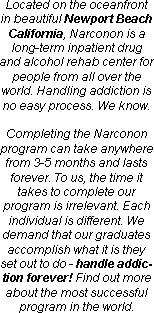
|
Navigate |
| Home |
| Kirstie Alley |
| Our 30th Anniversary |
| Never Turning Back |
| Narconon Endorsements |
| |
|
|
| |
|
|
| |
|
Facts About Drugs |
| FAQ About Ambien |
| FAQ About Ativan |
| FAQ About Cocaine |
| FAQ About Codeine |
| FAQ About Crack |
| FAQ About Darvocet |
| FAQ About Dexedrine |
| FAQ About Demerol |
| FAQ About Dilaudid |
| FAQ About Ecstasy |
| FAQ About GHB |
| FAQ About Heroin |
| FAQ About Hydrocodone |
| FAQ About Ketamine |
| FAQ About Lortab |
| FAQ About LSD |
| FAQ About Marijuana |
| FAQ About Morphine |
| FAQ About Meth |
| FAQ About Methadone |
| FAQ About Opiates |
| FAQ About Opium |
| FAQ About Oxycontin |
| FAQ About Percocet |
| FAQ About Percodan |
| FAQ About Ritalin |
| FAQ About Rohypnol |
| FAQ About Ultram |
| FAQ About Valium |
| FAQ About Vicodin |
| FAQ About Xanax |
  |
|
Resources |

|


 Print this article |  Send this article to a friend |  Add to Favorites |
FAQ
About Heroin
Q) What is heroin?
A) Heroin is an illegal, highly addictive opiate drug. Its abuse is more widespread than any other opiate. Heroin is processed from morphine, a naturally occurring substance extracted from the seed pod of certain varieties of poppy plants. It is typically sold as a white or brownish powder or as the black sticky substance known on the streets as "black tar heroin." Although purer heroin is becoming more common, most street heroin is "cut" with other drugs or with substances such as sugar, starch, powdered milk, or quinine. Street heroin can also be cut with strychnine or other poisons. Because heroin abusers do not know the actual strength of the drug or its true contents, they are at risk of overdose or death. Heroin also poses special problems because of the transmission of HIV and other diseases that can occur from sharing needles or other injection equipment.
Q) What are the current trends for heroin abuse?
A) A generation ago, the heroin (colloquially known as "smack") available in the U.S. was barely five percent pure and used by a relatively small percentage of young people because it had to be injected with a needle. Now, it appears smack is back with a vengeance and it's addicting large groups of new users.
The Office of National Drug Control Policy issued a report (April 1992, No. 5, pp. 1-6) claiming "a massive increase in heroin use and addiction is not likely." One reason for this was, "...the apparent absence of new initiates (i.e., heroin users with little or no prior drug-using experience)." However, based upon recent news reports and other sources (see the A.T. Forum Web site for News Updates), the ONDCP report appears to have been premature, to say the least.
Just this past February, Attorney General Janet Reno admitted heroin is more plentiful, purer, and less expensive than it was just a few years ago. "If we do not counteract the heroin threat now," she said, "we risk repeating the terrible consequences of the 1980s' cocaine and crack epidemic." Authorities estimate that heroin addiction has increased 20 percent and worldwide production has grown sharply, even as other illegal substance abuse is declining.
Reports of problems have sprung-up countrywide. In California, heroin sold in the San Joaquin Valley is cheap, potent, and plentiful - business is booming in area emergency rooms as two or three overdose cases appear each day. In Colorado, Boulder County officials may establish a methadone clinic for the first time in 16 years to deal with increasing heroin addiction. On the East Coast, heroin is reported to be 40 to 70 percent pure and around $10 for a small packet. The number of heroin-related hospital emergencies has more than doubled in New York City and surrounding areas.
Many drug abusers mistakenly believe inhaling heroin, rather than injecting it, reduces the risks of addiction or overdose. In some areas, "shabanging" - picking up cooked heroin with a syringe and squirting it up the nose - has increased in popularity. Street heroin carries prophetic names: "DOA," "Body Bag," "Instant Death," and "Silence of the Lamb." Rather than scaring off young initiates, the implied danger seems to actually increase the drug's allure.
Q) What are some other names for heroin?
A) "smack", "junk", "horse", "skag", "H", "China white"
Q) So Heroin is an opiate. What are some of the other opiates?
A) Opium, Morphine, Codeine, Merperidine , Hydrocodone (Lortab, Vicodin), Oxycodone (Percodan, Roxicet, Roxiprin, Tylox, Percocet), Stadol, Talwin, Dilaudid, Fentanyl, Buprenorphine, Methadone, Propoxyphene (Wygesic, Darvocet)
Q) What are the statistics on heroin addiction in the United States?
A) According to the 1996 National Household Survey on Drug Abuse, which may actually underestimate illicit opiate (heroin) use, an estimated 2.4 million people use heroin at some time in their lives, and nearly 216,000 of them reported using it within the month preceding the survey. The survey report estimates that there were 141,000 new heroin users in 1995, and that there has been an increasing trend in new heroin use since 1992. A large proportion of these recent new users were smoking, snorting, or sniffing heroin, and most were under age 26. Estimates of use for other age groups also increased, particularly among youths age 12 to 17: the incidence of first-time heroin use among this age group increased fourfold from the 1980s to 1995 The 1996 Drug Abuse Warning Network (DAWN), which collects data on drug- related hospital emergency department (ED) episodes from 21 metropolitan areas, estimates that 14 percent of all drug-related ED episodes involved heroin. Even more alarming is the fact that between 1988 and 1994, heroin-related ED episodes increased by 64 percent (from 39,063 to 64,013).
In 1996, it was reported that heroin was the primary drug of abuse related to drug abuse treatment admissions in Newark, San Francisco, Los Angeles, and Boston, and it ranked a close second to cocaine in New York and Seattle.
Q) How is heroin used?
A) Heroin is usually injected, sniffed/snorted, or smoked. Typically, a heroin abuser may inject up to four times a day. Intravenous injection provides the greatest intensity and most rapid onset of euphoria (7 to 8 seconds), while musculature injection produces a relatively slow onset of euphoria (5 to 8 minutes). When heroin is sniffed or smoked, peak effects are usually felt within 10 to 15 minutes. Although smoking and sniffing heroin do not produce a "rush" as quickly or as intensely as intravenous injection, NIDA researchers have confirmed that all three forms of heroin administration are addictive.
Injection continues to be the main method of use among heroin addicts; however, researchers have observed a shift in heroin use patterns, from injection to sniffing and smoking. In fact, sniffing/snorting heroin is now a widely reported means of taking heroin among users admitted for drug treatment in Newark, Chicago, New York, and Detroit.
With the shift in heroin abuse patterns comes an even more diverse group of users. Older users (over 30) continue to be one of the largest user groups in most national data. However, several sources indicate an increase in new, young users across the country who are being lured by inexpensive, high-purity heroin that can be sniffed or smoked instead of injected. Heroin has also been appearing in more affluent communities.
Q) What are the immediate (short-term) effects of heroin use?
A) Soon after injection (or inhalation), heroin crosses the blood-brain barrier. In the brain, heroin is converted to morphine and binds rapidly to opioid receptors. Abusers typically report feeling a surge of pleasurable sensation, a "rush." The intensity of the rush is a function of how much drug is taken and how rapidly the drug enters the brain and binds to the natural opioid receptors. Heroin is particularly addictive because it enters the brain so rapidly. With heroin, the rush is usually accompanied by a warm flushing of the skin, dry mouth, and a heavy feeling in the extremities, which may be accompanied by nausea, vomiting, and severe itching.
After the initial effects, abusers usually will be drowsy for several hours. Mental function is clouded by heroin's effect on the central nervous system. Cardiac functions slow. Breathing is also severely slowed, sometimes to the point of death. Heroin overdose is a particular risk on the street, where the amount and purity of the drug cannot be accurately known.
Q) What are the long-term effects of heroin addiction and use?
A) One of the most detrimental long-term effects of heroin is heroin addiction itself. Addiction is a chronic problem, characterized by compulsive drug seeking and use, and by neurochemical and molecular changes in the brain. Heroin also produces profound degrees of tolerance and physical dependence, which are also powerful motivating factors for compulsive use and abuse. As with abusers of any addictive drug, heroin addicts gradually spend more and more time and energy obtaining and using the drug. Once they are addicted, the heroin abusers' primary purpose in life becomes seeking and using drugs. The drugs literally change their brains.
Physical dependence develops with higher doses of the drug. With physical dependence, the body adapts to the presence of the drug and withdrawal symptoms occur if use is reduced abruptly. Withdrawal may occur within a few hours after the last time the drug is taken. Symptoms of withdrawal include restlessness, muscle and bone pain, insomnia, diarrhea, vomiting, cold flashes with goose bumps ("cold turkey"), and leg movements. Major withdrawal symptoms peak between 24 and 48 hours after the last dose of heroin and subside after about a week. However, some people have shown persistent withdrawal signs for many months. Heroin withdrawal is never fatal to otherwise healthy adults, but it can cause death to the fetus of a pregnant addict.
At some point during continuous heroin use, a person can become addicted to the drug. Sometimes addicted individuals will endure many of the withdrawal symptoms to reduce their tolerance for the drug so that they can again experience the rush.
Physical dependence and the emergence of withdrawal symptoms were once believed to be the key features of heroin addiction. We now know this may not be the case entirely, since craving and relapse can occur weeks and months after withdrawal symptoms are long gone. We also know that patients with chronic pain who need opiates to function (sometimes over extended periods) have few if any problems leaving opiates after their pain is resolved by other means. This may be because the patient in pain is simply seeking relief of pain and not the rush sought by the addict.
Q) What are the medical complications of chronic heroin addiction and use?
A) Medical consequences of chronic heroin abuse include scarred and/or collapsed veins, bacterial infections of the blood vessels and heart valves, abscesses (boils) and other soft-tissue infections, and liver or kidney disease. Lung complications (including various types of pneumonia and tuberculosis) may result from the poor health condition of the abuser as well as from heroin's depressing effects on respiration. Many of the additives in street heroin may include substances that do not readily dissolve and result in clogging the blood vessels that lead to the lungs, liver, kidneys, or brain. This can cause infection or even death of small patches of cells in vital organs. Immune reactions to these or other contaminants can cause arthritis or other rheumatologic problems.
One of the greatest risks of being a heroin addict is death from heroin overdose. Each year about one percent of all heroin addicts in the United States die from an overdose of heroin despite having developed a fantastic tolerance to the effects of the drug. In a non-tolerant person the estimated lethal dose of heroin may range from 200 to 500 mg, but addicts have tolerated doses as high as 1800 mg without even being sick[1].
Q) Are heroin users at special risk for contracting HIV/AIDS and hepatitis B and C?
A) Because many heroin addicts often share needles and other injection equipment, they are at special risk of contracting HIV and other infectious diseases. Infection of injection drug users with HIV is spread primarily through reuse of contaminated syringes and needles or other paraphernalia by more than one person, as well as through unprotected sexual intercourse with HIV-infected individuals. For nearly one-third of Americans infected with HIV, injection drug use is a risk factor. In fact, drug abuse is the fastest growing vector for the spread of HIV in the Nation.
Research has found that drug abusers can change the behaviors that put them at risk for contracting HIV, through drug abuse treatment, prevention, and community-based outreach programs. They can eliminate drug use, drug-related risk behaviors such as needle sharing, unsafe sexual practices, and, in turn, the risk of exposure to HIV/AIDS and other infectious diseases. Drug abuse prevention and treatment are highly effective in preventing the spread of HIV.
Q) How does heroin abuse affect pregnant women?
A) Heroin abuse can cause serious complications during pregnancy, including miscarriage and premature delivery. Children born to addicted mothers are at greater risk of SIDS (sudden infant death syndrome), as well.
Q) How stop using Heroin forever without becoming addicted to drug substitutes like Methadone?
A) The majority of treatment programs in the United States utilize the 12 steps derived from the Alcoholics Anonymous and Narcotics Anonymous programs as their foundation. In the past, the 12 step philosophy was combined with inpatient treatment in a hospital setting for a period of at least 28 days. Addicts would attend AA or NA meetings while receiving group therapy. Unfortunately, this model proved to be less than successful and the insurance industry has become unwilling to pay for extended stays. The current trend is to admit someone with a heroin problem to a hospital just long enough to get them through the worst of the physical withdrawal and then to send him to outpatient counseling. This method of treating heroin addiction is the most widely used and also the least successful Narconon Newport Beach takes an alternate more successful approach. Our program utilizes unique therapeutic training drills and instructional courses which address the underlying causes of addiction in an intensive manner and from many different angles. The result is a person who has dealt with the sense of hopelessness which, as it turns out, causes a person to start using heroin in the first place. This individual, in most cases, no longer feels the need to use heroin or any other drugs.
If you have a problem with heroin addiction call Narconon Southern California drug rehab center, we can help 1800 US NO DRUGS

comment corner
 |
| drug rehabilitation saving taxpayers |
California taxpayers are saving more money than expected due to ... |
 |
| Study: Marijuana Causes Lung Damage |
New research finds that smoking three or four marijuana cigarettes ... |
 |
| Thanks to Online Pharmacies, Addiction Can Be Just a Click Away |
WASHINGTON -- Kelly Knable, a 34-year-old mother of three from ... |
 |
| Balancing pain and drug addiction |
Over the past two decades, two conflicting medical ideas have ... |
 |
| Clean break |
... |
 |
| State officials create prescription drug abuse task force |
TALLAHASSEE, Fla. -- State officials on Friday announced the creation ... |
 |
| Florida system often fails to catch Medicaid abuse at source |
FORT LAUDERDALE, Fla. - (KRT) - The victim's skin was ... |
 |
| Marijuana's rising threat: For more kids, use turns into addiction |
John Brown experimented with marijuana at age 10, and it ... |
 |
| Student gets state prison term for selling marijuana |
EASTON -- David Messina had his whole life ahead of ... |
 |
| Man charged in cocaine case forfeits $585,000 |
An Iowa truck driver arrested by Kentucky Vehicle Enforcement officers ... |
 |
| Cocaine Curtails Body's Ability to Cool Off |
In addition to triggering life-threatening cardiovascular episodes, cocaine can be ... |
 |
| Science for Cops |
I admit it: I'm a Law & Order fan. ... |
 |
| New Gene Therapy Could Help Quell Alcoholic Cravings |
One prevailing view of addiction holds that alcohol and other ... |
 |
| One Dose of Cocaine Primes the Brain for Addiction |
It isn't a myth: one dose of cocaine is all ... |
 |
| Marijuana Firmly Linked to Infertility |
Scientists from the University of Buffalo have smoked out what ... |
 |
| Moderate Alcohol Consumption Clouds Brain's Ability to Detect Mistakes |
It's common knowledge that a brain on booze doesn't function ... |
|
Narconon Pictures |
|
   |
|